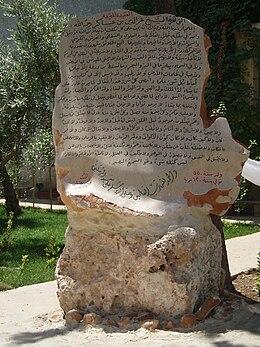
Back المدرسة النظامية Arabic المدرسه النظاميه ARZ নিজামিয়া মাদ্রাসা Bengali/Bangla Bagdadska nizamija BS Madrasah Nizhamiyah BTM Al-Nizamija Esperanto Al-Nizamiyya de Bagdad Spanish نظامیه بغداد Persian Al-Nizamiyya de Baghdad French अल निज़ामिया बग़दाद Hindi
| Part of a series on |
| Ash'arism |
|---|
 |
| Background |
Al-Nizamiyya of Baghdad (Arabic: المدرسة النظامية), one of the first nizamiyehs,[1] was established in 1065 in Baghdad. The Nizamiyya School was considered among the most important and prestigious educational institutions of the Abbasid era, alongside the Mustansiriya School. It has been described as the "largest university of the Medieval world."[2] The Nizamiyya school was completely Shafi'i. One of its requirements was that all teachers, preachers, and librarians be Shafi'i in jurisprudence and Ash'ari in theology. This school was home to prominent Shafi'i jurists including Abu Ishaq al-Shirazi, Ibn al-Sabbagh, Abu Sa'ad al-Mutawalli, Abu Hamid al-Ghazali, and Al-Kiya al-Harrasi.[3][4]
In July 1091, Nizam al-Mulk appointed the 33-year-old al-Ghazali as a professor of the school.[5] Offering free education,[6] Ibn Tumart, founder of the Berber Almohad dynasty, reputedly attended the school and studied under Al-Kiya al-Harrasi.[7][8] Nizam al-Mulk's son-in-law Mughatil ibn Bakri was also employed by the school. In 1096, when al-Ghazali left the nezamiyeh, it housed 3,000 students.[9] In 1116, Muhammad al-Shahrastani taught at the nezamiyeh.[10] In the 1170s, statesman Beha ud-Din taught at the nezamiyeh, before he moved on to teach in Mosul, while Imad ad-Din al-Isfahani studied there in the late 12th century. Others affiliated with the Nizamiyya of Baghdad include Asad Mayhani, Ayn al-Quzat Hamadani and al-Janzi.
The Persian poet Saadi Shirazi studied at the nezamiyeh during the early 13th century, when he set out on a journey. He was also among those who witnessed first-hand accounts of its destruction by Mongol Ilkhanate invaders led by Hulagu during the Sack of Baghdad in 1258. He recalls clearly his days of studies at the al-Nizamiyya in Baghdad "A fellow-student at Nizamiah displayed malevolence towards me, and I informed my tutor, saying 'Whenever I give more proper answers than he the envious fellow becomes offended.' The professor replied 'The envy of thy friend is not agreeable to thee, but I know not who told thee that back-biting was commendable. If he seek perdition through the path of envy, thou wilt join him by the path of slander.'"[page needed]
The curriculum initially focused on religious studies, Islamic law, Arabic literature, and arithmetic, and later extended to history, mathematics, the physical sciences, and music.[11]
- ^ Al-Ahram Weekly | Baghdad Supplement | They came to Baghdad : Its famous names Archived 2007-04-17 at the Wayback Machine
- ^ Kerski, Joseph J. (17 October 2016). Interpreting Our World - 100 Discoveries That Revolutionized Geography. Bloomsbury Publishing. ISBN 9798216104148.
- ^ al-Bayati, Tahir (8 September 2014). English in a simplified way. AuthorHouse. ISBN 9781491857649.
- ^ Youssef Al-Hazimari. "The biography of Imam Abu Ishaq al-Shirazi". Muhammadiya Association of Scholars (al-Rabita al-Muhammadiyya lil-'Ulamā' in Morocco). Archived from the original on 4 April 2024.
- ^ Ghazali
- ^ Black, A. A History of Islamic Political Thought – From the Prophet to the Present. Cambridge: Edinburgh University Press, 2001.
- ^ "Welcome | Religious Studies" (PDF).
- ^ Sharīf, Wilyam (2010). The Dearest Quest: A Biography of Ibn Tumart. Lulu Press. pp. 66–67. ISBN 9781445278254.
- ^ "Fastupdate sheet". www.ghazali.org. Retrieved 2017-09-13.
- ^ "Shahrastani". www.muslimphilosophy.com. Retrieved 18 March 2023.
- ^ B.G. Massialas & S.A. Jarrar (1987), "Conflicts in education in the Arab world: The present challenge", Arab Studies Quarterly: "Subjects such as history, mathematics, physical sciences, and music were added to the curriculum of Al-Nizamiyah at a later time."